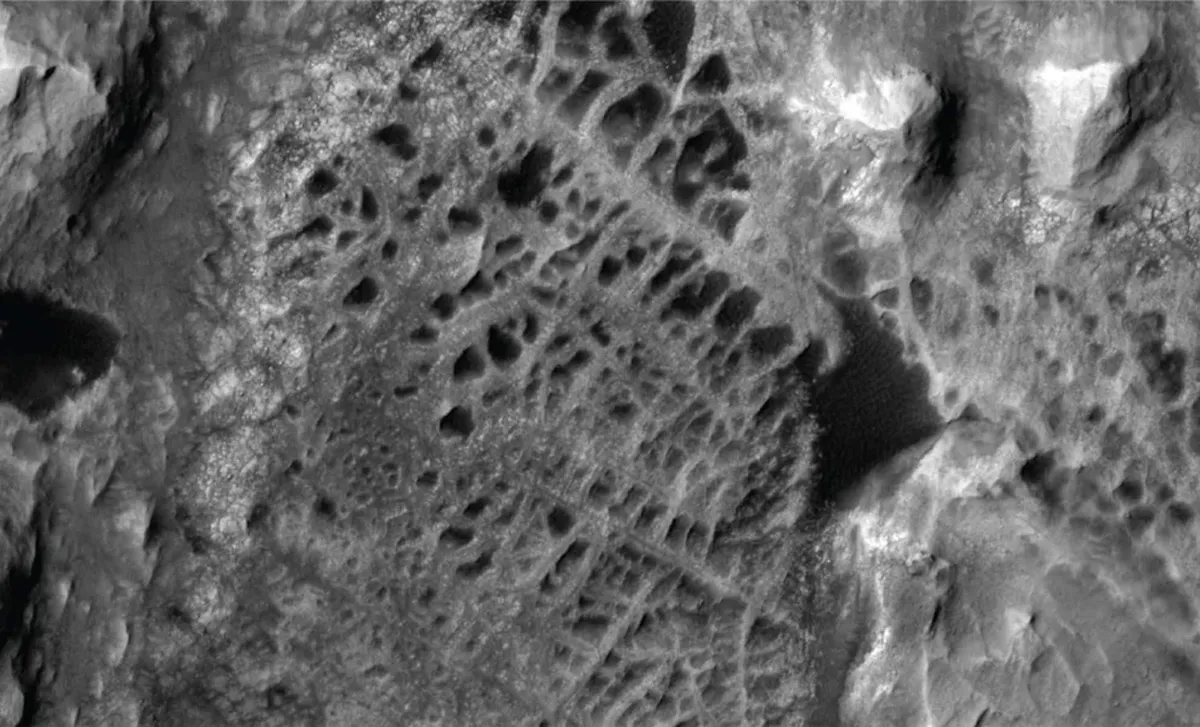
NASA’s Curiosity rover has made an exciting discovery on Mars, revealing its first close-up images of peculiar, web-like structures that resemble giant spiderwebs. These intriguing formations, known as “boxwork,” have captured the attention of scientists who believe they might offer significant insights into the planet’s past, particularly concerning the presence of water and the potential for extraterrestrial life.
The boxwork formations span up to 12 miles (20 kilometers) and consist of mineral-rich ridges that intersect in a unique criss-cross pattern. When observed from above, their structure evokes the appearance of webs spun by spiders, leading to their nickname. These fascinating features are part of a larger geological structure found on the slopes of Mount Sharp, situated in the heart of Gale Crater, where the Curiosity rover has been exploring since 2012. The formations were created by ancient groundwater that traversed the region, leaving behind mineral deposits that solidified over time. Prior to this revelation, scientists could only observe these formations from a distance through satellite imagery. However, Curiosity's recent close-up findings have provided researchers with valuable data and a deeper understanding of these structures and what they may reveal about Mars’ geological history.
The team behind Curiosity suggests that the boxwork ridges were formed through a process involving groundwater that infiltrated cracks and fissures in the Martian rock. This groundwater deposited minerals that accumulated and gradually hardened into cement-like structures. Over millions of years, the relentless Martian winds eroded the surrounding rock, yet the mineral deposits remained intact, resulting in the formation of these intricate ridges. On Earth, smaller versions of boxwork can be found on cave walls, where they develop similarly to stalagmites and stalactites. These Earthly formations often provide crucial clues about past environmental conditions within caves. With Mars presenting a larger scale of these features, scientists are optimistic that they will help unlock the secrets of the planet’s watery past and its potential to sustain life.
In addition to the first-ever close-up images of the boxwork formations, Curiosity also drilled into the rocks surrounding these features to collect samples for further analysis. During this process, the rover discovered veins of calcium sulfate, a salty mineral typically formed by groundwater processes. The significance of this discovery lies in the fact that calcium sulfate has never been observed so high up on Mount Sharp before. “This particular mineral hasn’t been seen so far up Mount Sharp before, so its discovery here is really surprising,” stated Abigail Fraeman, Curiosity’s deputy project scientist at NASA’s Jet Propulsion Laboratory. The presence of calcium sulfate adds further evidence that liquid water once flowed through this area, which could have been essential for the planet’s habitability in its ancient past.
The Curiosity mission team is particularly intrigued by these boxwork features as they may hold the key to answering fundamental questions about Mars’ capacity to support life. The minerals trapped within the ridges are believed to have crystallized underground, where conditions may have been more favorable, allowing for the flow of salty liquid water. These environmental conditions bear resemblance to those believed to have existed on early Earth, where microbial life may have thrived. “Early Earth microbes could have survived in a similar environment. That makes this an exciting place to explore,” noted Kirsten Siebach, a Curiosity mission scientist at Rice University. By examining the boxwork formations, scientists aim to glean essential insights into the possibility that Mars may have once hosted life, or might still harbor microbial organisms today. The findings from Curiosity could be vital in comprehending whether Mars was ever habitable and what the current conditions imply for future exploration efforts.